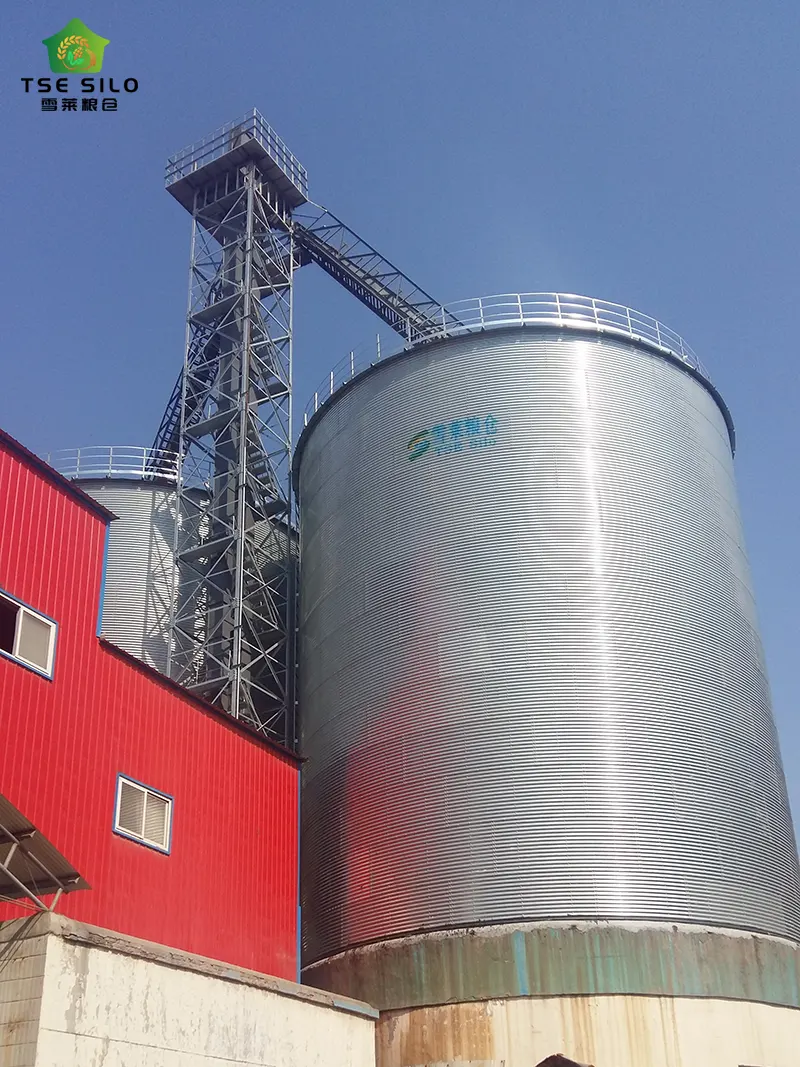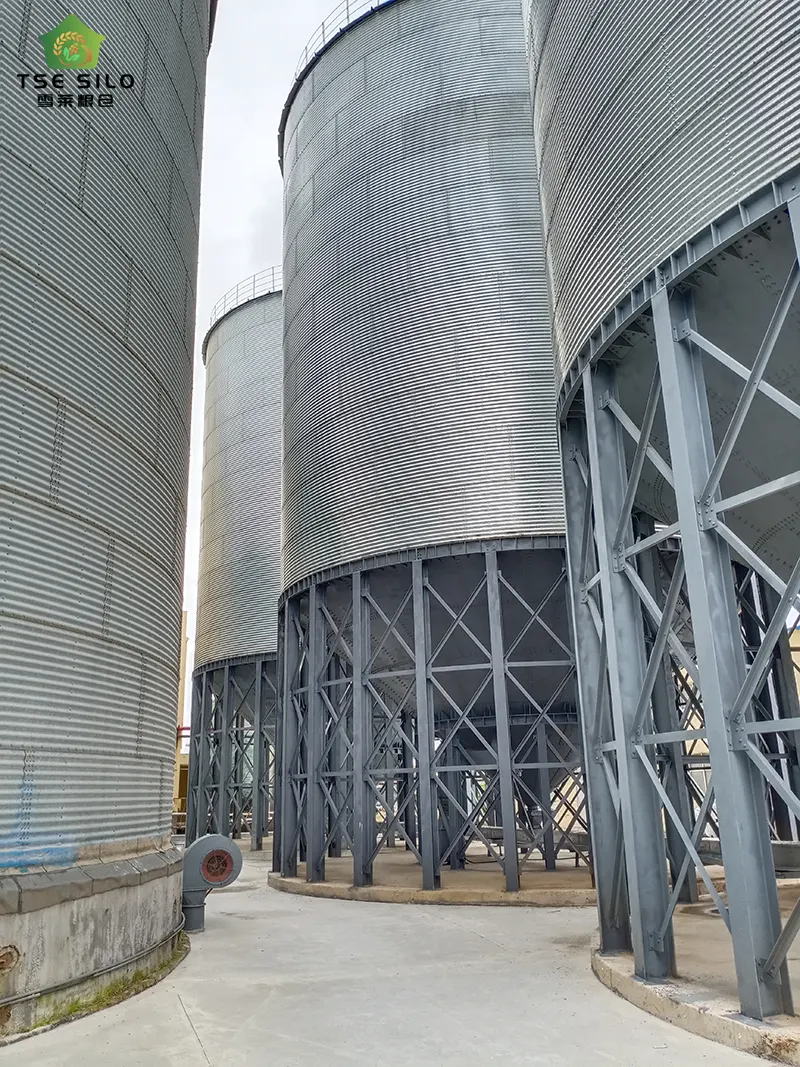Foundation preparation is crucial when constructing a grain steel silo. A poorly laid foundation can be fatal for equipment like silos with large load capacities. Therefore, before building a grain silo, the first step is to properly prepare the foundation according to the design drawings and requirements. Foundation preparation standards are generally determined based on the silo type and capacity. Today, we will explain the standard guidelines for foundation preparation for grain silo construction.
Steel silo foundation preparation standards are crucial for ensuring the safety, stability, and long-term operation of silos. They involve a series of rigorous survey, design, construction, and quality control requirements. The core goal is to control settlement (especially differential settlement) and provide sufficient bearing capacity and stability.


The following are the main standards and requirements for steel silo foundation preparation:
I. Core Principles and Objectives
- 1. Controlling Total Settlement: Preventing excessive settlement from impacting functional functions (e.g., discharge port height, connecting pipes, etc.).
- 2. Strictly Controlling Differential Settlement: This is the most critical objective. Excessive differential settlement can cause the silo to tilt, twist, weld cracking, or even collapse.
- 3. Meet bearing capacity requirements: The foundation must be able to safely withstand all combined loads, including the deadweight of the silo, stored material loads (static pressure and dynamic pressure from unloading), wind loads, and seismic loads.
- 4. Ensure stability: Prevent the foundation from sliding, overturning, or deep-seated instability.
- 5. Adapt to geological conditions: The treatment plan must be designed based on the specific engineering geology and hydrogeology of the site.
- 6. Durability: The foundation treatment materials and structure must be resistant to environmental factors (such as groundwater corrosion) and provide long-term stability.
II. Preliminary Survey Requirements
Detailed geotechnical survey: This is the foundation of foundation design and must be conducted by a qualified organization.
- Placement of survey points: The survey points should be spaced closely (e.g., 10-15m or closer). The survey points should penetrate the primary load-bearing strata and any possible weak underlying strata, and penetrate to a certain depth in the stable strata (usually ≥1.5 times the silo diameter or ≥15-20m, depending on the geological conditions).
- Survey Details:
- Soil layer distribution, thickness, and physical and mechanical properties (gravity, moisture content, void ratio, liquid/plastic limit, compression modulus/deformation modulus, shear strength index c, φ value, characteristic bearing capacity value, etc.).
- Groundwater type, water level, and its fluctuation range, and corrosiveness evaluation.
- Distribution and properties of adverse geological effects (such as collapsibility, dilatancy, cavities, landslides, liquefied soil layers, hidden banks/ponds, and fill).
- Evaluation of seismic effects (site classification, liquefaction identification).
- In-situ testing: Standard penetration tests, static cone penetration, dynamic cone penetration, cross-plate shear tests, and plate load tests are important means of obtaining key parameters.
- Indoor testing: Provides geotechnical parameters.
III. Foundation Treatment and Design Standards
1. Design Basis:
- Code for Design of Building Foundations
- Technical Specifications for Building Pile Foundations
- Technical Specifications for Building Foundation Treatment
- Design Specifications for grain steel silo for Grain or Relevant Industry Standards (e.g., silo design specifications for cement, chemical, and other industries)
- Code for Seismic Design of Structures
- Detailed geotechnical survey report.
- Structural design parameters of the steel silo (diameter, height, wall thickness, load, etc.).
2. Foundation Type Selection:
- Raft Foundation: The most commonly used foundation, suitable for sites with good foundation conditions (sufficient bearing capacity, low compressibility, and uniform soil layers) or effectively treated soil. Key design considerations include thickness, reinforcement, and settlement calculations.
- Pile Foundation: Suitable for sites with thick, soft soil layers, high bearing capacity requirements, strict settlement control, or adverse geological conditions such as liquefaction and collapsibility. Commonly used foundation types include cast-in-place piles and prestressed pipe piles. Design priorities focus on pile type, pile diameter, pile length, pile spacing, single pile bearing capacity, pile group effect, and settlement calculation.
- Composite foundations: These include CFG piles, cement-soil mixed piles, and gravel piles. Reinforcement is incorporated into the foundation to share the load with the soil between the piles. The bearing capacity and composite modulus of the composite foundation must be calculated, and settlement verification must be performed.
- Other: Ring foundations, independent foundations with coupling beams, and other methods may be used under specific conditions, but these are less common.
3. Settlement Control Standards (Core Indicators):
- Total settlement: Generally, it is required to be within the permitted range (specific limits are determined by the specification, the size of the silo, and its importance). Requirements are usually low (e.g., < 100mm or more stringent).
- Differential settlement/tilt: This is the most critical control indicator! Typical requirements include:
- Tilt rate: Foundation tilt (the ratio of the settlement difference between two points to the distance between them) is generally required to be within 0.2%-0.3% (i.e., differential settlement of no more than 2-3mm per meter). For large or important steel silos, the requirements may be more stringent (e.g., ≤0.15%). The specifications have clear provisions on this, which must be strictly adhered to.
- Local Tilt: The ratio of the differential settlement between two adjacent column or foundation points along the circumference of the silo wall to their distance must also be strictly controlled.
4. Bearing Capacity Verification:
- The foundation bearing capacity (characteristic bearing capacity of natural foundations, composite foundations, or single pile bearing capacity) must meet the requirements under all load combinations and provide sufficient safety margins.
5. Stability Verification:
- This includes anti-slip, anti-overturning (especially for tall silos or those located on slopes), and deep-seated stability (e.g., negative friction of pile foundations, overall stability analysis).
6. Seismic Design:
- For steel silos located in seismic areas, the foundation must undergo seismic verification, including bearing capacity, stability, and liquefaction identification and treatment. Earthquake-induced dynamic pressures and water pressures must be considered.
7. Special Foundation Treatment:
- Soft Foundation: Use replacement pads, preloading (surcharge/vacuum loading), composite foundations, pile foundations, etc.
- Collappable Loess Foundation: Eliminate collapsibility (e.g., dynamic compaction, compaction piles, pre-soaking) or use deep foundations to penetrate the collapsible soil layer.
- Expanding Soil Foundation: Use waterproofing, replacement fill, pile foundations, etc.
- Liquefied Soil Foundation: Use densification (vibration, compaction sand and gravel piles), dynamic compaction, enclosure, or use pile foundations to penetrate the liquefied layer.
- Karst, Soil Caves, and Hidden Rivers: Identify and address these (e.g., grouting, spanning).
- High Fill Foundation: Strictly control the quality of layered compaction, conduct post-construction settlement predictions, and utilize pile foundations when necessary.
IV. Construction Quality Control Standards
1. Construction must strictly adhere to the design drawings and construction plan.
- The design drawings are based on the geological survey, storage materials, customer needs and the surrounding environment. Therefore, we must install the drawings during construction and never change them without authorization. If you have any questions, please contact the drawing designer.
2. Foundation Pit Excavation and Dewatering:
- Ensure safety by using slopes or support systems. Implement dewatering measures to prevent flooding of the foundation pit and disturbance of the underlying soil. After excavation reaches the design elevation, promptly seal the bottom (e.g., pour a cushion layer).
3. Foundation Treatment Construction: (If used)
- Replacement Fill: Control filler quality, layer thickness, number of compaction passes, and compaction degree (≥0.95 or design requirements).
- Dynamic Compaction: Control tamping energy, spacing between tamping points, number of tamping passes, and the final tamping standard (average tamping depth of the last two blows).
- Composite Foundation: Strictly control pile position, verticality, pile length, pile material mix, pile construction process (e.g., shotcrete/powder quantity, lifting speed), mixing uniformity, and curing age. Post-construction pile quality testing (low strain, coring, etc.) and static load testing of the composite foundation are required.
- Pile Foundation: Control pile position, verticality, pile length, borehole quality (borehole diameter, sediment thickness), reinforcement cage fabrication and placement, and concrete pouring quality (slump, continuity, and conduit depth). After construction, pile integrity testing and static load tests for single piles and single pile composite foundations are required.
4. Foundation Construction:
- Bedding: Thickness, flatness, and strength must meet requirements.
- Rebar: Specifications, quantity, spacing, overlap length, anchorage length, and cover thickness must comply with the drawings.
- Formwork: Dimensions, location, rigidity, stability, and sealing must be strictly controlled.
- Concrete: Mix ratio, slump, pouring (layering, vibration compaction), and curing (time, humidity, and temperature) must be strictly controlled. Large volumes of concrete require temperature control measures.
- Embedded parts/bolts: Position, elevation, and verticality must be extremely precise (directly affecting the installation of the upper silo). They must be precisely positioned and securely fixed using dedicated fixing brackets. Care must be taken to prevent shifting during concrete pouring.
- Construction joints: Positioning and treatment must comply with regulations.
5. Backfill:
- After foundation construction is completed and strength is achieved, backfill symmetrically and in layers. Control the quality and compaction of the filler material to avoid foundation shifting due to unilateral compression.


V. Quality Inspection and Acceptance Standards
1. Process Inspection:
- Compaction, concrete test block strength, steel bar concealment inspection, and pile/composite foundation construction process monitoring (e.g., pile length, verticality, and pile construction parameters).
2. Final Inspection:
- Pile/Composite Foundation: Pile integrity testing (low-strain, acoustic transmission, coring, etc.), single pile bearing capacity static load test, and single pile composite foundation static load test (random sampling according to specification requirements).
- Natural Foundation/Bedding Foundation: Plate load test (for critical projects or complex geology).
- Concrete Strength: Test block compressive strength report, core sampling if necessary.
- Rebar cover thickness inspection.
- Foundation dimensions, elevation, flatness, and embedded component location inspection.
3. Settlement Observation:
- Construction Period: Settlement observation points will be established after foundation pouring is completed.
- Loading Period: Rigorous and frequent settlement observations must be conducted during silo installation and stockpile loading (especially during the initial full load). During the initial period of operation (usually 1-2 years), regular observations (e.g., monthly or quarterly) are still required. The interval can be extended as appropriate thereafter. The settlement stability standard is typically a settlement rate of less than 0.02 mm/day or compliance with regulatory requirements for two consecutive six-month observations.
- Observation Point Arrangement: Observation points should be evenly spaced along the perimeter of the foundation, with a sufficient number (usually ≥ 8) to clearly reflect overall settlement and differential settlement/tilt. Observation datum points must be located in stable areas.
4. Acceptance Documents:
- Complete geotechnical investigation report, foundation design documents, construction records, material inspection reports, test reports (bearing capacity, integrity, strength, etc.), settlement observation plan and records, hidden work acceptance records, as-built drawings, etc.
Summary and Emphasis
- Differential settlement control is the lifeblood of steel silo foundations. All design, construction, and monitoring efforts must revolve around this core objective.
- There is no one-size-fits-all standard approach. Individualized design must be based on a detailed and accurate geotechnical investigation report.
- Construction quality is paramount. Even the best design can lead to disastrous consequences if construction quality control is lax, especially when it comes to the positioning of pile foundations and embedded components.
- Settlement observation is the key to safety. It must be carried out throughout the entire construction and operation process, especially during the loading phase, to promptly detect anomalies and take corrective measures.
- Strict compliance with international and industry standards is essential.
- Therefore, foundation preparation for a steel silo is more than simply laying the foundation; it is a systematic project involving multiple disciplines, including geology, structure, geotechnical engineering, construction, and monitoring. It requires the utmost attention and sufficient technical expertise and resources to ensure that it meets stringent standards.
The above is our compiled and published guide to foundation preparation standards for grain steel silo construction. We hope it will be helpful for future grain silo construction. If you have any questions, please feel free to contact us.
Written by
Shandong Shelley Grain Steel Silo Co., Ltd
Editor Jin
www.grainstoragesilos.com
WhatsApp : +86-18653877118
Email : shelley@cnshelley.com






